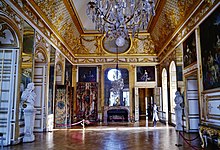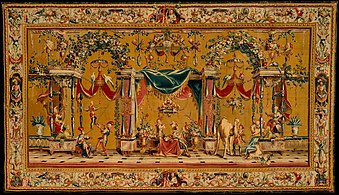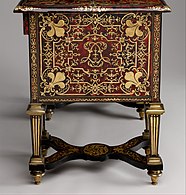Louis quatorze

Louis-quatorze is the name of the style that was widespread in the fine arts and handicrafts in France at the time of King Louis XIV's (French: Louis Quatorze ) exercise of power from 1661 , controlled by the state and representative of the absolutism of the Sun King, the after Louis XIII. named Louis Treize style. Its formal language can be assigned to the classicist baroque style that is widespread in France .
history
Jean-Baptiste Colbert , the general controller of finances, who was appointed surintendant des Bâtiments du roi, arts et manufactures and charged with glorifying the royal person and politics in 1664, pursued this goal by establishing or reorganizing the royal academies and the establishment of state workshops respectively the support of private workshops through the award of the title manufacture royale . For example, immediately after Colbert's predecessor in office, Nicolas Fouquet , Chief Financial Officer, fell out of favor, his tapestry factory, headed by Charles Le Brun , was confiscated and given royal privileges as Manufacture de tapisserie de haute lisse privilégiée , even before the earlier ones The Gobelin family's workshops were elevated to the Manufacture royale des Gobelins (1662) and the Manufacture de Beauvais (1664) were set up for the production of the precious picture knitting. From 1665 the tapissiers based in Aubusson were allowed to label their works with the seal MRD'A ( manufacture royale d'Aubusson ) (1665). Colbert founded the addition, the Manufacture Royale de draps fins (1665) in Abbeville for the production of fine cloth , promoted in Tours and Lyon -based silk weavers and supported the private, later in Saint-Gobain established when Manufacture royale des glaces de miroirs known mirror glass factory . The edict of the Manufacture royale des tapisseries et meubles de la couronne dates back to 1667 , which, in addition to tapestries, also made furniture and other art and furnishings.
Charles Le Brun had already designed the Vaux-le-Vicomte Castle together with Louis Le Vau and the garden architect André Le Nôtre between 1656 and 1661 , and Le Brun created the ceiling paintings for the Apollo gallery in the Palais du Louvre around 1661 . The Louis quatorze style, however, found its highest expression in the design of the interior of the Palace of Versailles by Louis Le Vau, Charles Le Brun, Jules-Hardouin Mansart , Robert de Cotte , which was ordered by Louis XIV and carefully observed by him in every detail . and their countless helpers.
description

Interior decoration in general
The peculiarities of the French Louis quatorze in comparison to the Italian-influenced Baroque lie in a more rational attitude, with an (even) stronger orientation towards classical models and an avoidance of too much exuberance and pathos. In terms of the interior decoration, this leads to a clear and clear division of the walls into separate fields, e.g. B. by pilasters or pilaster strips , or by geometric shapes. The walls are bordered at the top by an entablature (possibly with a frieze ). The principle of symmetry is also of crucial importance . Within this very rational structure on a large scale, a typical baroque tendency towards ornamentation and playfulness can develop on the small scale, for example in the form of grotesque decor, which is also symmetrically ordered.
In terms of interior decoration, two different phases of the Louis quatorze can be distinguished. The early phase up to around 1680–90 is still strongly influenced by Italian models (e.g. in Rome ) and strongly oriented towards a representative effect, with multicolored splendid marble decorations on the walls. Examples are the Grand Appartement du Roi and the mirror gallery in Versailles; in other palaces and in Vaux-le-Vicomte there are also colored wood paneling with very rich gilding. The ceilings are usually adorned with mythologically inspired paintings framed by magnificent gilded decorations.
Towards the end of the 17th century, this colorful and rather heavy, solemn style was replaced by a slightly lighter and, especially in winter, more comfortable variant, which consists of wood paneling with (usually) a white background and gilded carvings. The wall panels between the paneling can be covered with sumptuous fabrics such as velvet , silk or brocade, or with tapestries ; in addition or as an alternative there are mirrors and paintings . The most important examples of this are the king's bedroom and the anteroom with the porthole in Versailles in their form still visible today. The walls are partially structured by fluted, gilded pilaster strips, the ceilings are no longer decorated with paintings in both cases.
The decor of gilded carvings on a white background of the late Louis-quatorze also formed the valid foundation for the later styles of the Régence , the Louis-quinze and Louis-seize , only the ornamental forms used were modified, with a tendency towards less solemnity, less gold, and instead more and more lightness, playfulness (Louis-quinze, Rococo ), as well as intimacy and simplicity (Louis-seize, classicism ).
Painting and sculpture
Painting was based just as much on classical ideals as the other arts. Although there were ceiling paintings in France before (e.g. in the Fontainebleau Palace and in the Palais du Luxembourg ), the models for the elegant shapes of the ceilings in Versailles came from Italy, e.g. B. Carracci's ceiling decoration of the gallery in the Palazzo Farnese in Rome, other decorations by Lanfranco or Domenichino , or the rooms created by Pietro da Cortona in the Palazzo Pitti in Florence , which Le Brun knew. The ceiling paintings that the Roman classicist Giovanni Francesco Romanelli created in the Bibliothèque Mazarine and in the summer apartment of Queen Mother Anne d'Autriche in the Louvre in the 1640s and 50s are an even more direct model .
Painters of the Louis quatorze who contributed to the furnishing of Versailles or other castles were: Pierre Mignard , René-Antoine Houasse , Pierre Puget , Noël Coypel , Charles de Lafosse , Jean Nocret , Gabriel Blanchard , Jean Baptiste de Champaigne. The portrait painters Hyacinthe Rigaud and Nicolas de Largillière are also of particular importance .
The paintings in Versailles were by no means exclusively from contemporary artists. Louis XIV also had pictures hung by famous older painters whose style was "classical" or classicistic or who were recognized as classical, such as Titian , Veronese , Guido Reni , Domenichino , Lanfranco or Van Dyck . The French Nicolas Poussin , who lives in Rome, and the Lorraine landscape painter Claude Lorrain were also stylistic models for painting . The exuberant Italian-Flemish baroque style of Rubens , for example, was incompatible with the classical canon of forms of the Louis quatorze , although Le Brun himself was influenced by the Flemish at least in terms of color and painting technique. Other styles that were in some way extreme and deviated from the classically balanced elegance of the Louis quatorze - such as mannerist art of the 16th century or the hard and somewhat aggressive tenebroso style of Caravaggio - were not found in Versailles.

Antique models were also decisive for the elegant style of the sculptures; real antiques were also exhibited in the mirror gallery and in the grand apartment. Although Louis XIV had the famous Roman baroque artist Gian Lorenzo Bernini come to Paris in the 1660s, the richly moving and curved style of Italian baroque art was rejected in France. The famous exception to the rule is that King Bernini's portrait bust of himself was set up in the Dianasalon of the Grand Apartment. The extensive sculptural program - sculptures, reliefs, busts - of Versailles and other castles was designed by the artists: François Girardon , Antoine Coysevox , Gaspard and Balthasar Marsy , Jean-Baptiste Tuby , Pierre Le Pautre, Pierre Le Gros d. Ä. , Benoît Massou (1633–1684), Nicolas Coustou , Flemings, Le Comte et al
Furniture
Louis Quatorze-style furniture has survived relatively little, as almost all of the furniture in Versailles was sold or destroyed during the French Revolution ; the castle is therefore almost empty today. Several of the most important castles from the period, such as Marly , Saint-Cloud , the Tuileries Palace and the New Castle in Saint-Germain-en-Laye have disappeared, and with them their interiors. Other castles such as the Grand Trianon or Fontainebleau were often redesigned later and then received furniture in the corresponding styles.
The works of the important cabinet maker André-Charles Boulle are relatively well preserved ; they are particularly lavish and precious, with fittings made of gold-plated or silver-plated bronze and inlays ( marquetry ) made of various woods and other materials; other eminent artisans of the Louis quatorze are Pierre Gole , Alexandre Jean Oppenordt , and the royal watchmaker Jacques Thuret . The ornamental draftsman Jean Bérain the Elder also played an important role and designed many decorations, not only for furniture, tapestries and wall decorations, but also for theatrical decorations and costumes.
gallery
Tapestry Louis XIV's visit to the tapestry factory . You can also see furniture and objects made of silver and gold
King's room in Vaux-le-Vicomte with Louis quatorze-style furnishings
Louis quatorze furniture with cabinet by Pierre Gole , Paris, approx. 1665, various woods, ivory and gilded copper fittings; on top porcelain from Arita , Japan, late 16th century, California Palace of the Legion of Honor, San Francisco
Table by André-Charles Boulle , Paris, approx. 1670–1680, inlays made of various woods, brass, copper, horn, tortoiseshell, California Palace of the Legion of Honor, San Francisco
Furniture by André-Charles Boulle in the Salon of Abundance , Palace of Versailles
Armchair, last quarter of the 17th century, Metropolitan Museum of Art , New York
Armchair with tapestries in grotesque style by Jean Bérain the Elder Ä. , circa 1715, Metropolitan Museum of Art , New York
Louis quatorze furniture in the former apartment of Madame de Maintenon , Fontainebleau Castle
Tapestry with grotesque decoration by Jean Bérain the Elder Ä. , Metropolitan Museum of Art , New York
Alexandre Jean Oppenordt and Jean Bérain d. Ä. : Desk with hinged top ( bureau brisé ; side view), Metropolitan Museum of Art , New York. In the middle the initials of Louis XIV, in the corners French lilies
Louis quatorze-style furniture, around 1700, Département des objets d'art (room 38), Louvre , Paris
literature
- Germain Bazin : Dictionnaire des styles , Editions Aimery Somogy, Paris 1987, ISBN 2-85056-185-1 .
- Gérald van der Kemp: Versailles , translated from the French by Elisabeth Lysiak, Electa / Klett-Cotta, Stuttgart / Milan, 1977/1979
Web links
Footnotes
- ↑ The Royal Academy of Painting and Sculpture , founded in 1648, received new statues in 1664, and the Académie royale d'architecture was founded in 1671 .
- ^ Gérald van der Kemp: Versailles , translated from the French by Elisabeth Lysiak, Electa / Klett-Cotta, Stuttgart / Milan, 1977/1979, pp. 54, 58
- ↑ Only some of them are currently in their former location, others in the museum, van der Kemp names artists who originally hung in the grand apartment and the royal bedroom. Gérald van der Kemp: Versailles , translated from the French by Elisabeth Lysiak, Electa / Klett-Cotta, Stuttgart / Milan, 1977/1979, pp. 30–31 (Veronese's feast at Simon in the Hercules Salon), p. 40 (Veronese and Poussin in the Salon of Abundance), p. 50 (Domenichino = Domenico Zampieri, Tizian and Veronese in the Marssalon), p. 58 (Reni in the Apollosalon), p. 84–85 (Domenichino, Lanfranco, Van Dyck and Caracciolo in the king's bedroom)
- ^ Gérald van der Kemp: Versailles , translated from the French by Elisabeth Lysiak, Electa / Klett-Cotta, Stuttgart / Milan, 1977/1979, p. 46











